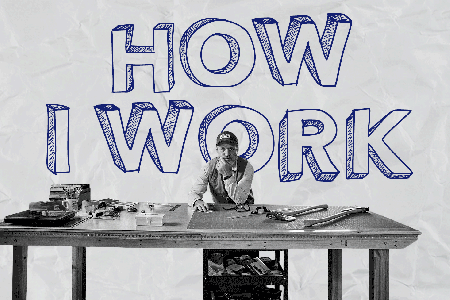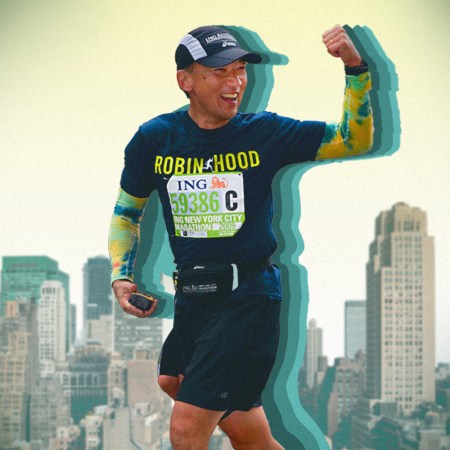Nota bene: All products in this article are independently selected and vetted by InsideHook editors. If you buy something, we may earn an affiliate commission.
This is How I Work, a series where founders, CEOs and leaders share the essentials that help them do what they do, from their morning routines to productivity tools.
The beginning of Brian Cook’s career as an entrepreneur will sound familiar: 80-hour work weeks, no time off on the weekend, productivity taking precedence over personal relationships. That’s the playbook that’s been pitched to business upstarts for the last few decades, and in some respects it’s worked beautifully for Cook. At 58 years old, he’s founded and sold a number of companies, including workflow software firm Nintex and employee directory app Hyperfish.
These days, he’s now shepherding a new firm from its explosive startup phase into its foundational phase, and I bet you can guess the tech they’re working on.
“If I wanted to create a voice AI company, the fastest way is to download some open source [tech] and point it at the internet and away you go,” Cook said on Zoom call earlier this month. “But the issue becomes: how do you know what your AI has ingested? How can you grant copyright to people? How do you have control over the quality?”
Cook is now the CEO of WellSaid, an AI voice-generation platform that has quickly made itself an invaluable tool for clients ranging from Amazon to Morgan Stanley to the U.S. Department of Homeland Security precisely because they have an answer to all the questions plaguing similar tech. Since the company was founded in 2018, it has made ethical and transparent production key pillars of its AI development: they know every voice that has gone into their AI, as they’ve come from paid actors who now get royalties, which means WellSaid actually has copyright over everything and brands won’t get sued for using it.
“It is very unique, and that’s because it’s not an easy approach,” Cook said. “It’s a slower approach. It’s taken a lot of effort to get the content and train all the voices that we’ve recorded.”
Harder still is remaining a leader in this space among the constantly evolving AI audio space, and convincing companies, lawmakers and the general public that ethical artificial intelligence is worth pursuing even as so many corporations and individuals are happy to scrape copyrighted information and ask questions later.
I recently caught up with Cook to talk about the work routine that helps him lead this new, cutting-edge team (his one-year anniversary with the company is coming up in January), the habits and tools he’s picked up over decades of helming other businesses, and why racing cars on the weekend — instead of pulling Saturdays and Sundays at the office — is the best thing a C-suite executive (or anyone, really) can do to reset for the week ahead.
This interview has been edited and condensed for length and clarity.
InsideHook: Tell me a little bit about where the company was when you started and what’s changed during your tenure.
Brian Cook: Like a typical startup, it sort of fumbled around, found its way. And then they had quite explosive growth. I think they got to the point where they thought, this is great, but as we take the thing to the next stage, it’d be great if we had someone involved that had been through it before. So we added a new CFO, a new chief product officer, a CIO, a head of marketing, and built out the team as we went. And then the second bit was about, how do we sharpen the spear? How do we focus the company? We’re in an environment where every day somebody’s throwing you a crazy use case and something that sounds really exciting and you want to go after it, but you have to be super disciplined about what you’re going to do and what you’re not going to do. I like to create “We Will Not” lists — lists of the things that we won’t do, because I think that’s as much about focus as anything else.
Can you give me an example of one use case that shows one end of the spectrum for WellSaid’s voice generator and one use case on the other end?
We had NPR use WellSaid to create a Planet Money episode that was completely AI-generated. We have somebody that uses WellSaid for a yoga application, so you can download an app and go through yoga and meditation and they are WellSaid voices. It’s all over the spectrum. But the place that we really see our strength is around enterprises in either creating training materials or in marketing and advertising.
How big is the WellSaid team now?
We’re about close to 80 people. It’s not a huge company. We’re always trying to do more with less, automate as much as possible, have software contribute as much [as possible].
Is there a central WellSaid office?
When I started, the business was basically everybody working remotely. I recognized pretty quickly that it’d be great to have an office where we could get together, so we got a new office about four months ago in Kirkland, Washington. And that’s been great. I’m in the office every day. Most of the leadership team is in the office every day and teams take turns at coming in when it makes sense. It’s just good to get people face to face around a whiteboard and being able to evolve ideas and work together. I think it makes a big difference.
You’ve been involved in many companies, started your own companies. Are you a big proponent of the office as an essential place for creativity for the team, for productivity, all those things?
Absolutely. Personally, I’m terrible at working from home. I get distracted. But at the same time, WellSaid’s a company that grew up during COVID and we have to respect that people are living different lives and live in different ways. We have a majority of our company that’s never seen the office, and that works fine. We cater for that. Part of the challenge is how do you make people feel like they’re not missing out?
Since you’re going into the office every day, what’s your morning routine like?
I’m not a crazy early riser, but if I can, I try and get a workout in most days of the week. And I do the school bus drop. A good day is if I can be in the office by 8:00 a.m. I’m a big planner, so I’ll spend the first 15 minutes of the day figuring out what I’m going to do, plan the day and step back and say, “What do I need to achieve today and the rest of the week?” I’ve learned that every dollar you spend planning, you get $10 back in results.
When you do get a workout in, what are you doing?
I do a bit of motor racing, so I try to train for that. So that’s Peloton, every second day, and then every off day would be core training or weight training. Then I’ve started doing yoga as I get older, which has been super helpful.
It’s funny that you mention Peloton because in the first story I did for this series, Peter Buchanan-Smith of Best Made also said he loves Peloton and swears by it. But in the culture we’ve had this moment where everyone seems to think, oh Peloton’s over. So why do you like it?
Yeah, I don’t like it. [laughs] I hate it. It’s just a super effective use of time. In car racing, you’re in a hostile environment. It’s hot. There’s a lot of pressure mentally. There’s a lot of G-forces. You’ve got moments where your heart rate will be really high and you’ve got to try and get that heart rate back down again. So Peloton and doing HIITs, you try and get your heart rate down. That sort of fitness is core to being able to be calm and level-headed in a race car.
How I Work: Best Made’s Peter Buchanan-Smith Swears by Pencils, Peloton and a Riding Lawn Mower
As he relaunches the company he founded in 2009, the axe evangelist shares the key elements of his work routineIs car racing something that you’ve done your whole life?
I guess I was driving cars quickly from the time I got my first car, but I couldn’t afford to do racing or anything more serious. I got into go-karting in my 30s, which I thought was a fantastic sport. I was building one of my first companies at that time and what I loved about car racing is you would spend a weekend doing that and it completely clears your brain. If you’re going to be driving at 100 miles an hour around a track, you have to have 100% focus. You can’t be thinking about next week’s board meeting or the kids or whatever. It’s 100% focus or you will crash, or at least embarrass yourself. I find it a way to reset over a weekend to the point of, on Sunday nights, I’m normally scratching my head trying to remember what I do again.
I think that’s super healthy. When I was starting my first serious company, I was working crazy 80-hour weeks and working all weekend and not having a break and all the rest of it. It’s not a very good use of time, but it’s also not a great way to be a CEO. Not only is it the issue with stamina and health, but it’s hard to have a clear head if you’re just in it flat-out every day working on the business.
You just had a pretty significant racing win recently.
Yeah, I race in a series called the Ferrari Challenge. It’s identical Ferraris. Ferrari puts on a great program, and you’ve got either usually successful business people or their children racing. We run the North American series, so we do seven races, six in North America and one in Italy, and I won the AM Championship in that this year. It was great to have a goal outside of work to focus me on my training and health and so forth.
When you’re back in the office on Monday, what’s on your desk? What are the essentials?
It’s pretty clean. It’s pretty zen. There’s a PC, there’s my phone, there’s some sticky tape and a stapler, but there’s not a lot here.
You don’t have a zen garden or anything like that?
I had a zen garden once in a previous business and it flipped over on the floor. I thought, I’m never doing that again. But, no, nothing freaky.
In terms of planning, are there task management or scheduling apps that you rely on?
Over the years I’ve tried a whole bunch of methods and task lists and all the rest of it and I go back to the same process: I use a [Microsoft] OneNote. I like to have a top 10 list of things to do, and there’s never a number 11. If it’s the 11th, it doesn’t get looked at. I like to work in batches if I’m working on a particular project. I’m big on putting the head down, work for an hour, then come up, check the emails, check what needs to be done. I’m big on removing any sort of real-time notifications. I think that context switch is expensive mentally, so I’ve learned to turn all that stuff off.
A tool that I really love: I use a Mindjet MindManager. That’s something I got on two years ago. It’s a way of organizing thoughts and organizing content, and I live by it. I use it to generate ideas and so forth, so that’s one of the secret tools that I use. Well, it’s not so much a secret these days.
Say you need some creative inspiration, you’re stuck on a project. What do you do?
I was a musician in my younger life. I worked at nights doing music and playing in bands and running companies during the day. We used to do recording and songwriting, and we’d always find that whenever you got stuck, try to bring in some kind of unexpected outside influence. I apply that to what I do now, that if we get stuck, if we really feel like we’re going nowhere, then let’s do something random, let’s introduce someone that we don’t expect, or let’s just break things up and do something crazy. Like, let’s go downtown and ride on the monorail. I find that those types of things will potentially unlock thoughts but also just introduce different influences to be able to come up with new ideas and move things forward.
I remember the stories about Brian Eno, the producer of U2, that whenever they got stuck he had his box of cards and he’d pull a card out at random and it would say, “A waltz in G major.” And the band would just start: “Okay, well, that’s a crazy idea. But hey, what about it?” I like that.
Are there any books you’ve found enlightening in terms of being an entrepreneur, being a business leader, something that actually rang true for you?
When I first got my first company, my co-founder and I drew straws on who would be CEO after a while. I then found myself thinking, “I have no right to be here. What do I do?” I was lucky enough to spend time with the founder of a major software company in Australia and said that to him. He said, “Well, I had no idea what to do, but all I did was just read everything that I possibly could.” And so I did that. I read every single business book that I could, and there’s lots of good stuff and there was lots of rubbish. That had a huge impact on the way I thought about business and management style and all the rest of it.
I didn’t go to business school, so that was how I learned. I’m a big fan of Clayton Christensen and The Innovator’s Dilemma and his follow-up book, so anyone in product development or marketing, go read this book so you know what I’m talking about. I think he’s super important. I’m a huge fan of Jim Collins and Good to Great and that series of books. Jim Collins wrote a book that’s not so well-known called How the Mighty Fall and it’s the study of what makes a great company stumble and fall. I find that absolutely fascinating, what that research suggested. I also love Seth Godin and the classic Purple Cow. I got a chance to meet him a few years ago and he’s always been an inspiration for coming up with ideas that are outside the square.
I can see you’re wearing a watch right now. What is it?
I’ve got an Apple Watch. [laughs] It’s the Ultra. It’s got a fancy band. I love it. I’ve gone through the man-jewelry, fancy-watch stage and I just keep coming back to the Apple Watch.
But do you turn the notifications off when you need to get work done?
No…but I do in the race car. I had a situation recently where we were racing at Watkins Glen, which is a high-G track, and the watch kept calling my wife and saying I’d had a fall, that it’s an emergency. It’s kind of weird, Siri yelling at you as you’re driving at 170 miles an hour. So I turn it off in the car now.
Apple didn’t plan for that when they were designing that feature.
Yeah, it literally started calling people in my address book, which I thought was pretty funny.
We've put in the work researching, reviewing and rounding up all the shirts, jackets, shoes and accessories you'll need this season, whether it's for yourself or for gifting purposes. Sign up here for weekly style inspo direct to your inbox.

























